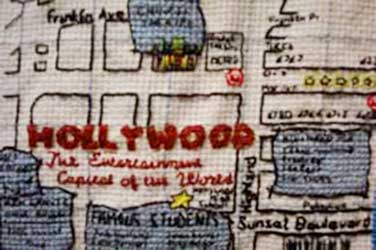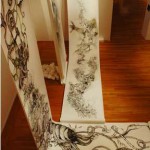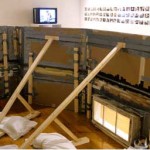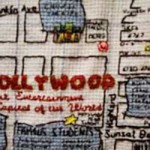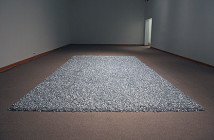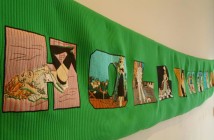Every spring Boston enters its "congrats to the grads" phase. You start getting invites or evites to graduation parties. You buy the same cards, recite the platitudes, and the ubiquitous "what now" finds its way into your conversations with the newly educated. For the art fan, it's the season of "Thesis Shows." Even for the interested it can be overwhelming. Which ones should you see? While there, how do you make sense of it? With so much screaming for your attention, its easy to slip into auto pilot and chant congratulations. Cynicism aside, for someone hungry for something new-student shows can be quite a buffet.
I was fortunate the day I visited Tufts in that the weather was exceptionally warm, and that I had a personal tour guide. Add to this that my guide was Evelyn Rydz, an artist in the show and I was more than ready to jump into the pomp and circumstance. I congratulated myself on my good fortune and together Evelyn and I made our way to the gallery to see "Thesis III." When we got there I suggested we see her work first and she graciously obliged. As I rounded the corner, the sight that came into view, just blew me away.
Three scrolls of white paper hung down from a system of twisted metal tubing and speakers. Hung away from the wall, their twenty-foot plus lengths spilled out across the floor giving it the feel of free-standing sculpture. It reminded me of a giant fax machine that had just finished transmitting a long and coded message. All of this was staging to the real stars of the installation-the drawings. "Mapping Lineage" was a good choice for a title. These lines "mapped" something but what it was remained elusive within the drawings' inventive linear structures. Though abstract, they were full of suggestions that evoked, things as disparate as veins, wires, graffiti, seismic readings, impossible landscapes, even tattoos. The fluidity of their serpentine contours transitioned my eyeballs with ease from one pictorial event to another. Like a film these drawings were sensed in both time and rhythm. The underpinning of all of this was doodling. Rydz loves this graphic vernacular in part because it's an art that all of us make, a familiar vocabulary. The transposition of this "low brow" mark making into, symphonic-like compositions reinterpreted the act of doodling and its traditional associations. The central drawing (my favorite) was marked by a large hole that seemed carefully torn. The shredded remains of it were neatly piled up behind the piece. In this drawing absence was carefully fore-grounded. Far from stopping there, it introduced yet another layer into the work's formal and emotive complex. Overhead the speakers played sounds of scratching pencils and voices- the sounds of the studio. This stretched the installation's reach by pushing it into the sonic realm. Rydz's work powerfully proclaimed that drawing is still full of possibilities.
What is real, can art ever be so? A question like this can be boring but in the work of Hillary Baldwin, the second stop on our trip, it was a question compounded by humor and profundity. The scene that lay before us seemed an odd assortment of junk or maybe at best flea market leftovers, like old Christmas lights, a soda can, a bit of linoleum tile etc. Only on closer inspection and help from Evelyn was their careful fabrication made evident. These were crafted sculptures made to look like found objects-second hands handmade. The work that got me the most were the pile of potato chips made from clay. Maybe it was the hidden sub-text of the statement that grabbed me. Think about it. Here were sculptures of something that isn't really real anyway. Potato chips really aren't food, is sculpture of them real sculpture? I love the way this installation drew me in and repelled me at the same time. These were things that ordinarily you might kick down the street, but here they were carefully offered up for delectation. These objects were so mundane that their careful re-creation seemed less ironic and more a good-natured try at reclaiming some value from the discarded.
Just a walk to the left and we were in Hollywood amongst the glitterati, soaking in a wash of flashbulbs and drinking bubbly with all the cool people, or at least we were playing in their world. The world of Gina Dawson has a lot to do with play. Several intricate dioramas were placed on shoulder high tables. The tableaus of Hollywood star's homes were complete with working hot tubs, manicured lawns, beautiful people, and Gina? That's right, Gina placed herself in the middle of it all in the form of a crude doll made out of "Sculpey", a school child's medium. It was hilarious, but it was more than just jokey. It was personal, even devotional would not be pushing it. They were like shrines to some nirvana that Dawson could only get to by way of her imagination. My favorite showed her in a park making out with X Files star, David Duchovney, while overhead a UFO threatened to abduct them. There was a tragicomic quality to all of this. The scenes were funny but they also felt sad and nostalgic for something we all have wanted to be- the star.
Downstairs, artist Juniper Perlis was keeping a vigil, living in a partial re-construction of her father's house. Her father and his whereabouts were two questions central to Perlis's thesis. To the right a wall of photographs narrated her search for her father. Though her father's identity does not surface in this photographic investigation, Perlis's thoughts on the nature of that identity surface. This gave the photos a two way read. On the one hand they were pictures of strangers, on the other they were intimate snapshots of Perlis herself. Perlis finally found her father's home and secretly rummaged through his trash barrel for information about his plans and activities. Some of this collected evidence was strewn about the gallery floor. The house piece was really the most striking. What kept me staring was that it was so obviously incomplete. Scrupulous attention was paid to replicating the exterior exactly while the inside, was devoid of detail. It was supported on wooden beams, like a stage prop, and you could see that it was made from cardboard, wood, and ductape. The front of her father's house was all she had access to and so the interior of her house sculpture was simply left empty. Perlis's placement of her body into that naked space, that knowledge vacuum, painfully demonstrated her longing for inclusion into a world that had long remained mysterious.
In conclusion, I would like to say something fitting to all these talented artists and congratulations just won't cut it. What I really wish for each of them is success, but that's a loaded term and no matter how you slice it, in the art world- to some it can only mean money, and publicity.
Now that these artists have left the protective cocoon of art school behind, they face a harsh world where talent is but one of many stocks in trade. In this flight or fight situation, today's best art grads rely on the generosity of our (the public's) support and our critical attention.
For now its hats-off to Rydz, Baldwin, Dawson and Perlis, but I hope all of us will put on our thinking caps when considering the future for art in Boston, and how the art schools will influence it. The health of the Boston art scene is assured so long as we make concerted efforts to widen the field to new and challenging voices.
- Evelyn Rydz, Mapping Lineage, acrylic, ink, and color pencil on paper, 2005
- Juniper Perlis reconstructs her father’s house in her performance installation Father Series, 2005
- Gina Dawson, detail from Movie Star Homes, custon cross stitch, 2005
Links:
Tufts University Art Gallery: Thesis Exhibitions
"The April SMFA/Tufts MFA Thesis Exhibition" was on view until April 24th date at the Aidekman Arts Center on the Tufts University campus in Medford, MA.
All images are courtesy of the artists and the Aidekman Arts Center.

